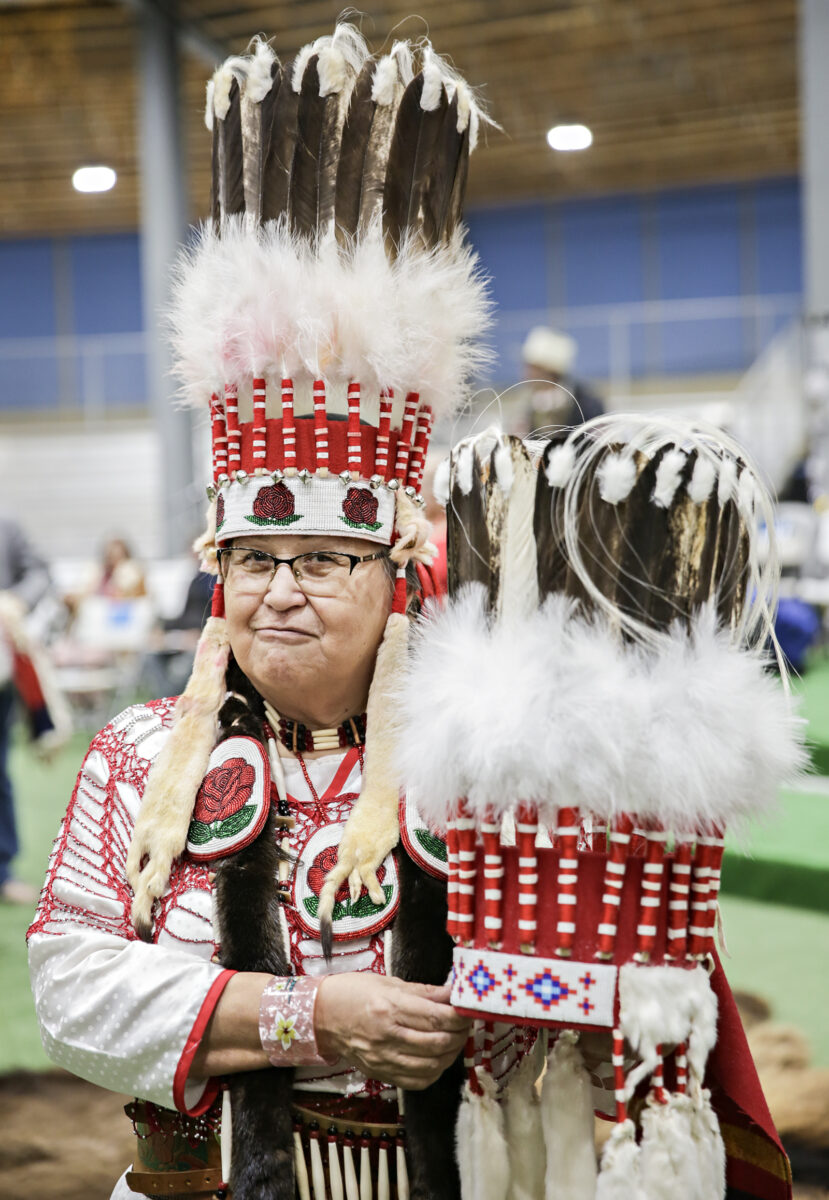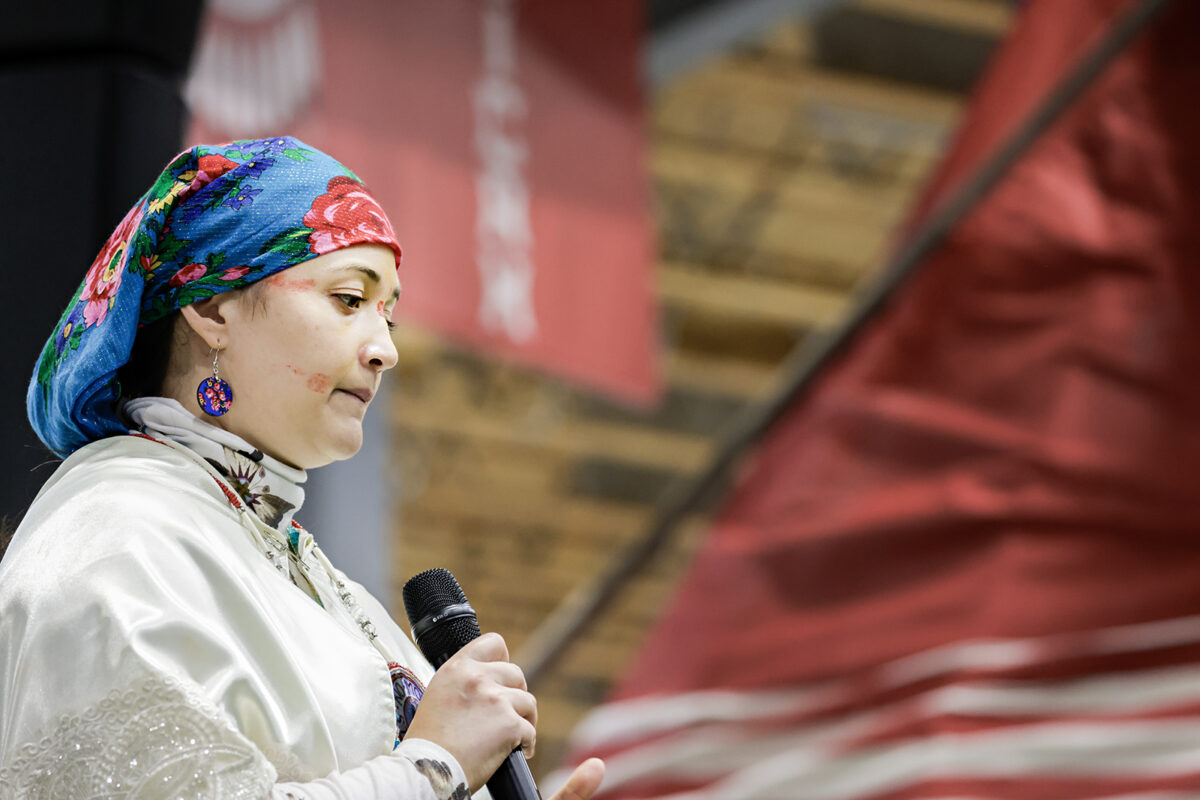With Lily Gladstone Day, the Blackfeet Nation Embraces a Star
The March 26 event in Browning included the transferal of a stand-up headdress to Lily Gladstone, the history-making actress recently nominated for an Academy Award
By Mike Kordenbrock
Flipping through the pages of a handmade, laminated book with the words “For Lily” on its cover, it becomes possible to imagine what Lily Gladstone means to some of the youngest members of the Blackfeet Nation who were on hand to see her this Tuesday at a community-wide gathering and ceremony in Gladstone’s honor.
The book was by the young students in Marci Burd’s first-grade Blackfeet language immersion class at Bullshoe Elementary, and its pages shows the earnest pride and emotion the children feel toward Gladstone’s success as an actress, and her embrace of Blackfeet language and culture on some of Hollywood’s biggest stages.

Drawings form the centerpiece of each page and some of them are marked by the broad, lightly shaded strokes of a colored pencil moving fast. They show Gladstone in various settings, sometimes on stages, sometimes surrounded by words like “Netflix,” and often holding awards. And beneath each drawing are small messages written out on tall, bold lines, their center bisected by the dash-marks that offer a helping landmark to those who are first learning how to write and shape letters.
“Thank you for speaking Blackfeet to the world,” one student wrote.
“Lily you are powerful,” another student declared. On one page, a first-grader proclaimed to Gladstone: “You are unstoppable.”
On Tuesday, the book was brought by Burd to the Blackfeet multipurpose arbor in Browning, as a gift for the Blackfeet Nation’s biggest star, who was on hand for what the tribal business council proclaimed “Lily Gladstone Day.” It was just one of many gifts to Gladstone given to her by people who have watched her rise to stardom, following an arc that in the last year alone has earned her a Golden Globe, a Screen Actor’s Guild Award, and an Academy Award nomination for best actress, making her the first Native American to receive the coveted Oscar nod. The accolades were conferred on Gladstone for her role in director Martin Scorsese’s “Killers of the Flower Moon,” in which she portrayed Mollie Burkhart, a member of the Osage Nation and a central figure in the “reign of terror” that befell the Osage less than a century ago. Gladstone is of Blackfeet and Nimiipuu descent, and is a University of Montana graduate who at a young age lived in Browning and East Glacier Park before her family later moved to Seattle.
At the center of the day’s events was the transfer of a straight-up headdress to Gladstone, which is a specific type of regalia worn only by certain Blackfeet tribal members and descendants. To have a stand-up headdress transferred is a high honor and Gladstone’s grand entry before the ceremony was watched by hundreds and hundreds of people who packed the arbor on a day that began with single-digit temperatures and fog before giving way to sunshine holding the promise of spring’s growing strength. More people watched livestreams online. Throughout the room, cell phones and tablets were held aloft, as people tried to capture with photos and videos the moment of Gladstone’s arrival.

Gladstone was preceded by a color guard of Blackfoot veterans bearing different flags. She walked in with family around and behind her, as the procession continued with dozens and dozens more people, including tribal royalty and leadership, Browning schools leadership, and members of different societies, including a contingent of women who have also been honored with the stand-up headdress, many of whom count themselves members of a group called the Women’s Stand-up Headdress Society.
From there, the celebration began with a flag song from the Willow Creek Drum Group, a recitation of Gladstone’s family history, an opening prayer sung in Blackfeet by first-graders (among them Burd’s students), kindergartners, and students at Cuts Wood School and De La Salle School, a song by Cobyn Eagle Speaker of Heart Butte School, and an honor song by the Young Grey Horse Society. Tribal officials and dignitaries also delivered remarks to the large audience before the transfer ceremony began with Gladstone kneeling across from Charlene Plume, who made the headdress and was responsible for transferring it to Gladstone.

The expansiveness of the moment, and the day, briefly gave way to a moment of intimacy and privacy. Members of the media were asked to pause taking photos and videos while Plume painted Gladstone’s face, and various society members formed a semicircle around the two and opened their coats to further create a visual barrier between that moment of the ceremony and the surrounding audience.
Then society members moved aside, allowing people to see Gladstone as she received the headdress, and began to hug and embrace, one by one, the women gathered around her, all of whom also wore the headdress with its distinctly upright plume of eagle feathers arranged in a circle.
Those first hugs were the beginning of what seemed to become a community-wide embrace of Gladstone. She was eventually escorted around the room, occasionally holding her hand over her heart and gesture to the crowd, and pausing at different points around the arbor’s perimeter, before people began to line up for an opportunity to meet her. People congratulated her, shook her hand, embraced her, offered her gifts, asked for autographs, and posed with her for photos. Those in line ranged in age from tribal elders all the way down to infants in the arms of their parents.

One such parent, Racheal Briere-Grant, held her 2-year-old son River in her arms while she took a photo with Gladstone. Briere-Grant said she wanted the photo because Gladstone is a role model for young kids.
“She’s from here, and she’s just showing other kids that if you keep following your dreams, you can too, you know? Not just in acting, but in anything you choose to do,” Briere-Grant said.
Gladstone met with people for around an hour before Jesse DesRosier, the emcee of the event, announced that she would be taking a break. Around the same time, a community feed began, with meals given out to all in attendance.
As DesRosier explained at one point in the afternoon, Gladstone didn’t simply receive the physical object of the stand-up headdress as a result of the ceremony.
“There’s also a spiritual aspect of that represented in the song and the ceremony,” he said. “Because this was a transferred act, that song, that war bonnet we see on her head today, is now a part of her being. As Blackfoot people we look at ownership in a completely different way … In Blackfoot, when we own something it becomes a part of our body. Or it’s a relationship we share with another being, such as marriage, or a domesticated animal. This transferred object you see today, is now a part of Piitaaki (Eagle Woman). No matter where she goes that is now a part of her.”

Ahead of the event, DesRosier had explained that for Gladstone to receive the headdress is an indication of how highly leaders within the tribe view her. DesRosier said that, from his perspective, she has been a “tremendous” representative of the Blackfeet people.
“She always starts with the Blackfoot language, and that is just huge when it comes to representation, and proper representation,” he said, adding that she has used her platform to highlight bigger issues in Indian Country. “Whether it be missing and murdered Indigenous women, educational resources, sovereignty, whatever the issue, I mean, she really knows how to get our voice out there in a good, positive way.”
All told, Gladstone visited with hundreds of people in a process that lasted for hours, continuing even after the event had officially ended. Speaking afterward, William Gladstone, her second cousin, said that Lily is a selfless person who knows how to treat people and whose humble appearance is not an act.
“She’s been this way her entire life,” he said, before remarking on the significance of the day having brought all four bands of the Blackfoot Confederacy together, with some people having made the trip from Canada in order to be in attendance.
When it came time for Lily Gladstone to address those in attendance she began her comments in the Blackfoot language before continuing in English.

“I love all of you,” Gladstone said, pausing as people shouted, cheered and clapped. As she shared during her speech, her parents wanted her to be born in Browning, and so they moved back during Indian Days in 1986, and she was born two weeks later. During that early part of her life, she recalled living not far away from the grounds where the new arbor now stands, saying that she could always hear what was going on at the campgrounds, and always wanted to be there. She also addressed the young kids in attendance, saying that what they had heard earlier in the day was true, if you work hard, you can do it.
“So being here with you right now, is really a full-circle moment. It feels amazing,” Gladstone said, adding that she feels blessed and lucky to be Blackfeet. Gladstone told the crowd that they brought her up, and that she continues to do her best to bring everyone up with her.

“It’s a really special thing to be who we are. To be from where we’re from and I know sometimes it can be a really hard thing too. But all good things are hard things and we share, and we take care of each other,” Gladstone said. “And I wouldn’t be here, I wouldn’t have been able to do anything good with my life if I didn’t come from good people, and it’s amazing to be back here with all of you, all of you good people.”